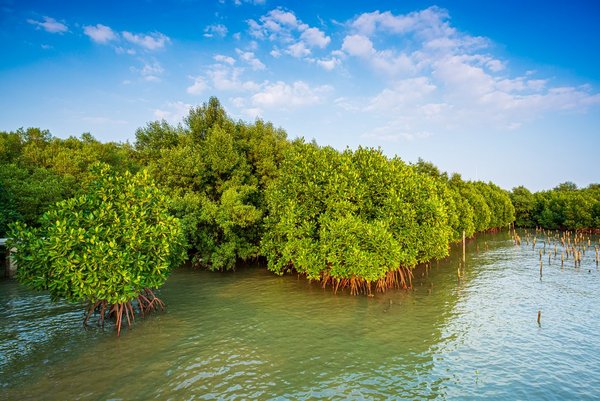 Read this article in French
Read this article in French- Share this article
- Subscribe to our newsletter
Preserving natural habitats to protect coastal areas
People living in low-lying coastal areas will be at even greater risk from cyclones in the future. Natural ecosystems offer protection, but this protection has decreased in recent years and is expected to continue to decline. This is a finding of a model study by an international team of researchers led by ETH Zurich/Switzerland published in November 2023.
An annual average of 67 million people living in low-lying coastal areas world-wide are currently at risk from cyclones. The greatest number of these people (in absolute terms) is in China, where 40 million people are at risk each year. Many coastal residents in Japan and the Philippines are also at risk from cyclones, with 11 and 9 million people respectively threatened each year.
If climate change continues, the number of people in coastal communities at risk from cyclones in all regions could increase by 40 per cent to an annual average of nearly 94 million by 2050. In absolute terms, that is 27.3 million more people per year than today. These calculations do not include population growth or rising sea levels.
Natural protection crumbling away
Natural coastal habitats such as mangrove forests, reefs, seagrass or salt marshes can protect people living near them from tropical cyclones by breaking tidal waves, slowing wind gusts or absorbing floodwaters like a retention reservoir.
This protection currently benefits 21 per cent of people at risk of cyclones. However, the level of protection varies greatly from region to region. In the Virgin Islands in the Caribbean, 92 per cent of people living in the danger zone are protected by natural shorelines, while in Vietnam the figure is just 11 per cent.
In addition, the protective effect has decreased over the past 30 years. Today, 1.4 million more people are unprotected and at risk from cyclones each year than in 1992. This is mainly due to the destruction of ecosystems. The researchers estimate that protection by natural coasts will continue to decline until 2050.
At the same time, population density has increased along coastlines in recent decades, and more so along stretches where protective ecosystems are no longer present.
Another factor in reduced protection relates to how climate change is expected to alter the occurrence of cyclones. In the future, these will appear in places where they weren’t expected even just a few years ago.
Protection takes priority over restoration
It is immensely important to protect existing intact coastal habitats, the researchers say. It is also important to restore lost habitats, for example by planting mangroves. However, the benefits provided by restored habitats are often fewer than those provided by natural habitats. That means protection takes priority over restoration.
The potential to offer people better protection against cyclones by restoring mangrove forests is especially great in island states in the Caribbean (like Bermuda or Trinidad and Tobago) and in the Pacific (like Papua New Guinea). In Bermuda, two-fifths of those at risk from cyclones would benefit from such measures.
(ETH Zurich/ile)
Read more on the ETH Zurich website





Add a comment
Comments :